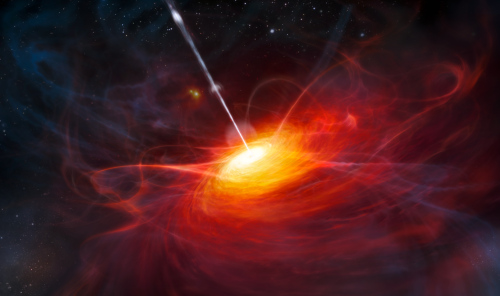
This artist's conception provided by the European Southern Observatory shows ESO's Very Large Telescope and a host of other telescopes' discovery of the most distant quasar found to date. This brilliant beacon, powered by a black hole with a mass two billion times that of the Sun, is by far the brightest object yet discovered in the early Universe. (AP-Yonhap News)
LOS ANGELES (AP) _ A team of European astronomers, glimpsing back in time to when the universe was just a youngster, says it has detected the most distant and earliest quasar yet.
Light from this brilliant, starlike object took nearly 13 billion years to reach Earth, meaning the quasar existed when the universe was only 770 million years old _ a kid by cosmic standards. The discovery ranks as the brightest object ever found.
To scientists' surprise, the black hole powering this quasar was 2 billion times more massive than the sun. How it grew so bulky so early in the universe's history is a mystery. Black holes are known to feed on stars, gas and other matter, but their growth was always thought to be slow.
The discovery was reported in Thursday's issue of the journal Nature.
Since quasars are so luminous, they guide astronomers studying the conditions of the cosmos following the Big Bang, the explosion believed to have created the universe 13.7 billion years ago. Researchers are constantly trying to outdo one another in their quest to see the universe as an infant. The deeper they peer into space, the further back in time they are looking.
The previous record holder was a quasar that dated to when the universe was 870 million years old.
The new quasar _ with the tongue-twisting name ULAS J1120+0641 _ was identified in images from a sky survey taken by the United Kingdom Infrared Telescope perched near the summit of Mauna Kea, Hawaii. The discovery was confirmed by other telescopes.
``It's like sifting for gold. You're looking for something shiny,'' said lead researcher Daniel Mortlock, an astrophysicist at Imperial College in London.
In an editorial accompanying the research, Chris Willott of the Canadian Astronomy Data Center called the quasar a ``monster'' that could upend current theories about the growth of black holes.
``The existence of this quasar will be giving some theorists sleepless nights,'' said Willott, who was not part of the discovery team.
<한글 기사>
129억년 전의 가장 밝은 퀘이사 발견
유럽 과학자들이 129억 광년 떨어진 우주 가장자리에서 초기 우주의 것으로는 가장 밝은 퀘이사를 발견했다고 네이처지 최신호에 발표했다.
퀘이사는 중심부에 있는 초거대 블랙홀로부터 에너지를 공급받는 극도로 밝고 먼 은하로 준성(準星)으로 불리기도 하며 지구에서 관측할 수 있는 가장 먼 거리의 천체이다.
칠레 소재 유럽 남부천문대의 극대망원경(VLT)을 비롯한 여러 망원경을 이용해 발견된 퀘이사 ULAS J1120+0641은 태양 질량의 20억 배나 되는 거대한 블랙홀로부터 에너지를 공급받고 있으며 지금까지 초기 우주에서 발견된 천체 가운데 가장 밝은 빛을 내는 것으로 밝혀졌다.
연구진은 "빅뱅 후 단 7억7천만년 후의 모습을 보여주는 이 퀘이사는 초기 우주의 활동을 보여주는 결정적인 증거이다. 이는 초거대 블랙홀이 빅뱅 직후 수억년 사이에 어떻게 자라났는지 이해하는 데 도움을 줄 것"이라고 말했다.
현재까지의 가설에 따르면 초거대 블랙홀은 느리게 성장하는 것으로 예상되고 있는데 이 퀘이사의 존재는 이런 가설에 의문을 제기하는 것이다.
지금까지 이보다 먼 감마선폭발(GRB)과 은하가 발견된 적이 있긴 하지만 이번에 발견된 퀘이사는 이들보다 수백 배나 밝다. 연구진은 자세히 관찰할 수 있을 만큼 밝은 천체 가운데서도 이 퀘이사는 단연 가장 먼 것임을 강조했다.
지금까지 발견된 두 번째로 먼 퀘이사는 빅뱅 후 8억7천만년 전의 모습으로 나타나고 있다.
연구진은 적색편이 6.5 이상의 퀘이사를 찾기 위해 5년에 걸쳐 2천만 개의 천체 들을 샅샅이 뒤진 끝에 적색편이 7.1의 ULAS J1120+0641을 찾아냈다. 이들은 "우주를 통틀어 적색편이 7 이상의 밝은 퀘이사는 100개 정도밖에 안 될 것"이라고 말했다.
적색편이는 천체로부터 온 빛이 도플러 효과에 의해 본래의 파장보다 긴 붉은 파장 쪽으로 이동하는 현상을 가리키며 편이의 크기는 거리에 비례하기 때문에 이를 통해 정확한 거리를 알 수 있다.
(연합뉴스)






